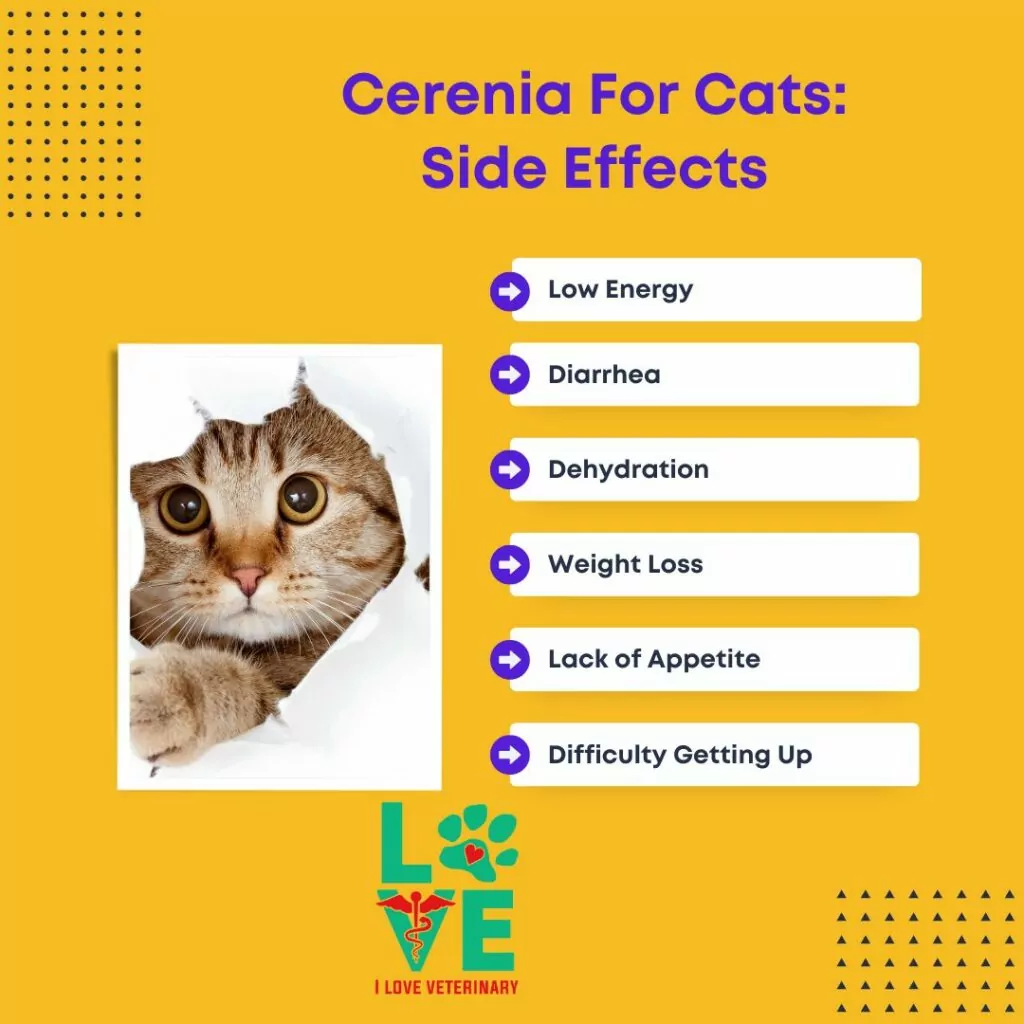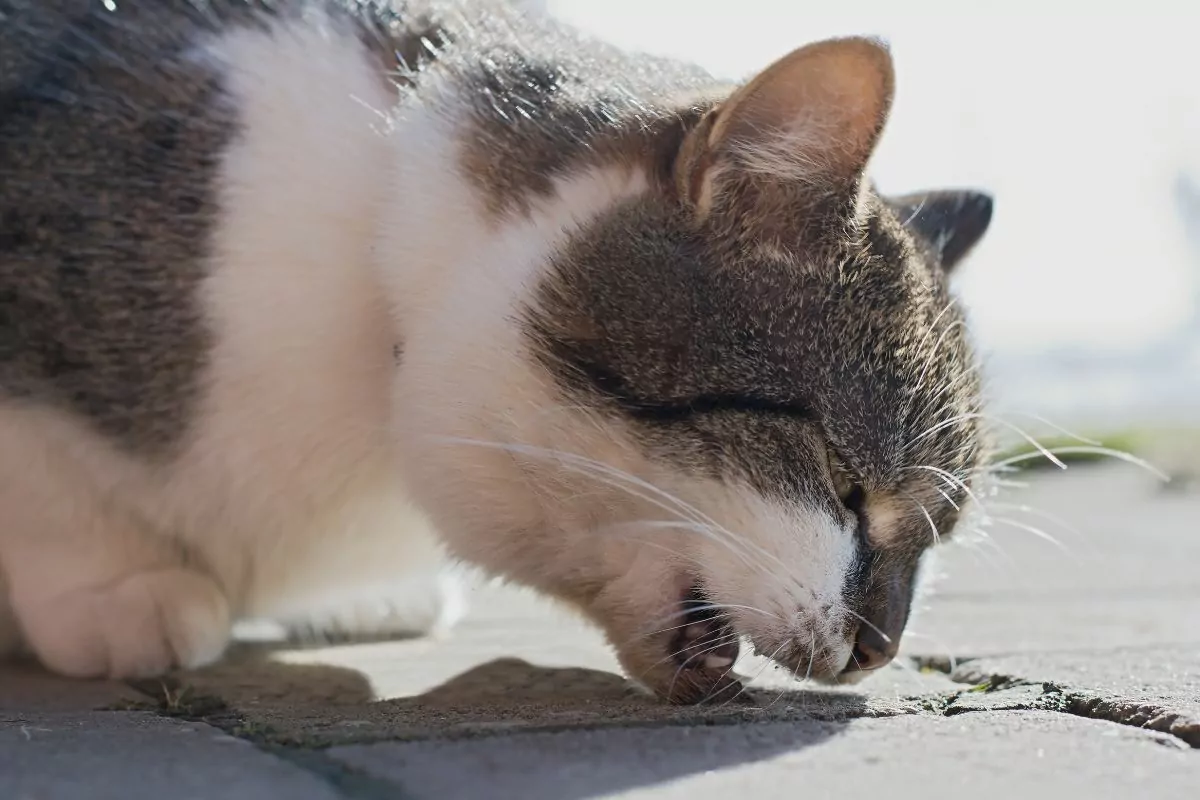What is Cerenia for Cats?
If you have ever been nauseous, you know how uncomfortable it can be. It’s no different for our beloved cats; luckily, Cerenia for cats is there to help!
Cerenia is the brand name for Maropitant Citrate, a drug used to treat vomiting and nausea in cats and dogs. But how does it work, and what are the possible side effects of Cerenia for cats? Keep reading our comprehensive guide to find out!
The Different Forms of Feline Cerenia
Cerenia, or feline Maropitant, is a type of medication that the FDA first approved in 2007. However, at the time, only for dogs who were experiencing vomiting or suffering from motion sickness. Some veterinarians also started using it for cats, but at the time, it was off-label. In 2012 Cerenia was approved by the FDA for cats and dogs!

The most common form of Maropitant is Cerenia tablets for cats. however, the Cerenia injection for cats is also frequently used – especially when a patient is too sick to swallow the pill.
The Cerenia cat tablet is a small oval yellow or peach-colored tablet with a score in the middle, meaning you can easily break it apart. Each tablet has the letters’ MPT’ for Maropitant stamped on them and the strength in milligrams.
The injectable medication is a clear liquid that a veterinarian can inject quickly as an intravenous solution or subcutaneous (right under the skin).
What Is Cerenia Used for in Cats?
The primary purpose of Cerenia is to work as an antiemetic (to stop vomiting) in combination with other supportive therapy and as an anti-nausea medication. Especially in cases where a cat is suffering from motion sickness.
The short explanation for motion sickness in cats, and most other mammals, is that the brain senses movement from the inner ears, eyes, muscles, and joints. When these signals do not match, motion sickness can occur. To alleviate this in our household cats, a veterinarian can prescribe Cerenia – or other types of Maropitant.
But Cerenia isn’t just for motion sickness. A veterinarian can also prescribe and administer Cerenia to alleviate nausea in cases where the cat is otherwise sick.
A cat can be vomiting or feeling nausea due to a long list of reasons, the most common ones being:
- Cat intestinal diseases.
- Pancreatitis in cats.
- Infections and inflammations.
When a cat is feeling ill, it is essential to keep them eating – although cats will often walk away from their food, refusing to eat when suffering from even a mild case of nausea.
The lack of eating is always an issue with sick animals, but even more unfortunate with cats, as cats need to eat continuously to survive, especially when ill. That is why Cerenia is so helpful alongside supportive therapy in many cases, to keep the cat eating and thereby help ease the recovery.
However, it is essential to remember that a veterinarian, in most cases, prescribes Cerenia as a type of supportive therapy to alleviate discomfort and help further diagnostics.
Stopping the vomiting or alleviating nausea may only mask a symptom – not cure the condition. The underlying reason for the vomiting or nausea needs diagnosing and primary treatment.
Veterinarians Prescribing Cerenia for Cats
For example, veterinarians frequently prescribe Cerenia for cats with kidney disease as nausea is a common symptom of chronic kidney disease.
This is why you should never administer Cerenia for cats without consulting a veterinarian first. A cat that isn’t eating is always something to worry about, and you must uncover the underlying cause.
Lastly, some veterinary professionals also use Cerenia as nasal drops. No formal studies support the Cerenia for cats’ anti-inflammatory effect when used intranasally. Still, some anecdotal evidence exists for using it in cats with severe rhinitis (inflammation in the nasal regions).
Some studies suggest that substance P (the substance Maropitant in Cerenia inhibits) is present in the airways following severe inflammation. It explains that inhibiting the substance may help quell the inflammation. However, there are no formal studies, so the efficacy may be limited.
Cerenia for Cats – Side Effects

Like all types of medication, there are some Cerenia side effects you should be aware of when administering the medication to your cat. Luckily these are often relatively mild, with serious side effects considered very rare.
The most common reaction is a mild response at the injection site. However, these will almost always disappear within 24 hours and rarely needs treatment.
In studies made, other side effects associated with Cerenia for cats were:
- Dehydration in cats.
- Feline fever.
- Lethargy (tiredness).
Cerenia is considered a very safe way to treat vomiting and help alleviate the discomfort associated with nausea. If you are worried your cat is experiencing an untoward reaction to the medication, you should seek veterinary care.
How Long Does it Take for Cerenia To Work?
In most clinical studies, Maropitant citrate took effect within an hour of being administered as an injection, subcutaneous or intravenous in dogs and cats. One of the most significant benefits of Cerenia is that it works for nearly 24 hours, meaning it is only necessary to administer the medication once daily.
The Different Cerenia Doses Explained
Cerenia is most often given as tablets as these are easy for in-home administering, with the Cerenia tablet dose for cats being dependent on the weight of the cat. As an injectable, the quantity will often be.
- 0.00004oz/2.2lbs (1mg/kg) bodyweight
(Please note that the dosage may vary upon location.)
A Cerenia dosing chart is sometimes helpful when administering tablets for dogs, but it is rarely necessary for cats as they are almost always smaller than dogs.
With the injection, the dosage can be exact, whereas, with tablets, the dosage will depend on the tablet that can get as close as possible to the correct dose. The tablets are available as 0.00005, 0.00008, or 0.002oz (16mg, 24mg, or 60mg) tablets. The most used one is Cerenia 0.00005oz for cats (Cerenia 16mg for cats), often split into two or smaller parts.
The medication will need to be administered once daily, often for five days or continuously if your cat is being otherwise treated and supported. If you miss a dose of Cerenia at home, your cat may start experiencing nausea again, resulting in decreased appetite and possibly vomiting.
However, there are no severe risks associated with missing a dose of Cerenia, and you can give it to your cat when you remember. Just remember to push the next amount to the equivalent hours to ensure your cat receives no more than one dose every 24 hours.
Risks Associated With Maropitant Citrate
There are very few risks associated with giving your cat Maropitant citrate. That said, it should never be provided without the guidance of a licensed veterinary professional, as it, for example, should not be given to patients suffering from liver disease in cats or in cases where an intestinal blockage is suspected.

Cerenia Drug Interactions
Another bonus of Cerenia is that there are no reports of contraindications when using Cerenia alongside other types of medications. That means Cerenia is ideal for use in animals experiencing vomiting or nausea in response to diseases, infections, or similar situations.
Cerenia can block some Calcium-blockers, meaning the medication will be less effective, which is essential to remember.
How to Store Cerenia for Cats
Cerenia tablets for cats should be stored at room temperature and away from animals and children. If you break the foil package, you should give the tablet within two days.
You can also store the Cerenia injection liquid at room temperature until your or the veterinarian breaks the seal; hereafter, you should store it in a refrigerator. Most veterinarians keep the Cerenia constantly in the fridge as some anecdotal evidence suggests that it stings less when given when cold subcutaneously.
A Maropitant Citrate Info Chart
If you are struggling to keep up with all this new information, here is a quick summary of what Maropitant is!

How Does Cerenia Work?
But how does Cerenia, and Maropitant in general, work to stop the vomiting? Cerenia for cats, or Maropitant Citrate in general, works by inhibiting a neurotransmitter (a communication molecule) within the brain called substance P.
Substance P is the transmitter that tells the brain that “something bad is happening in the stomach” and then tells the body to empty its stomach— activating the feeling of nausea to get the process started.
When Maropitant Citrate inhibits and stops substance P, the transmitter can no longer signal to the brain that it needs to empty the stomach. Slowing down and possibly stopping, these signals will reduce the feeling of nausea and, in effect, inhibit the response of vomiting altogether!

Recap
We all hate feeling ill and nauseous, but unlike us, our cats will quickly deteriorate when they don’t eat for extended periods. That’s why Cerenia for cats is an excellent addition to any veterinary practice, supporting cats getting back on their feet sooner rather than later!
